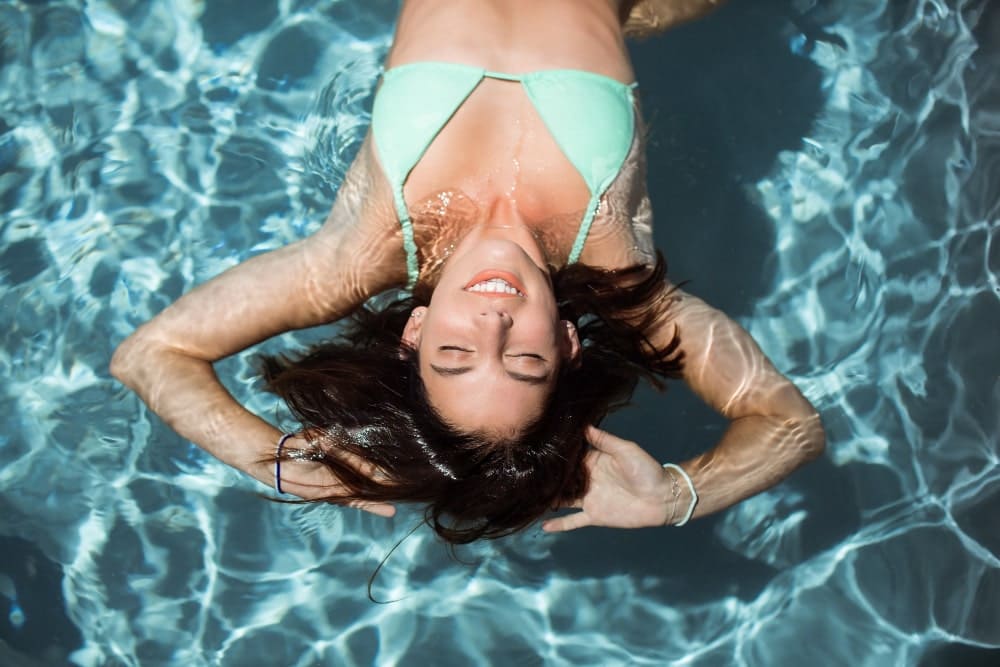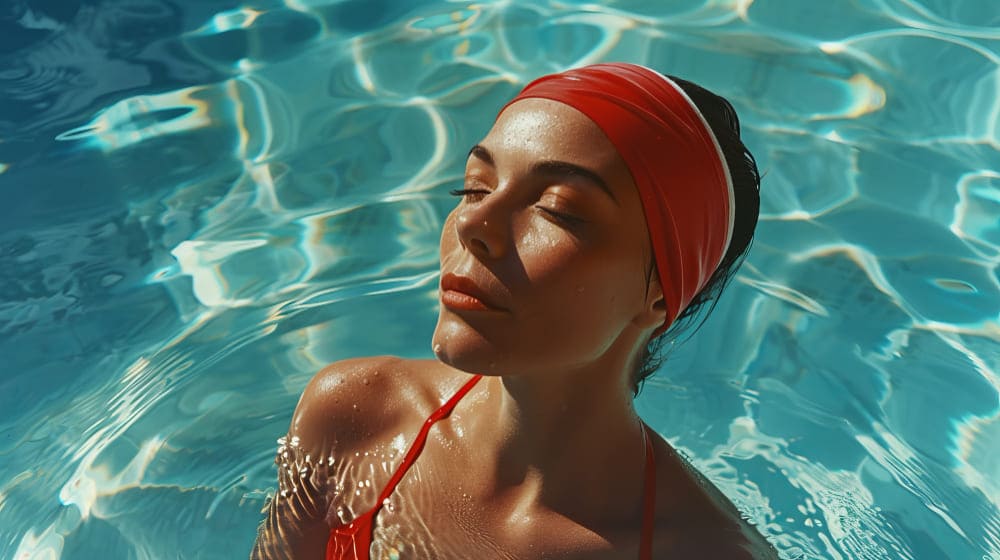Swimming and hair: what is the problem? Chlorine, which is usually present in the swimming pool, is top-notch for water cleaning, however, it may be notorious for your hair. Its drying effect strips the hair of its herbal oils, causing it to become brittle and vulnerable. These are common reactions to topical swimming. Over time, ordinary contact with chlorine has the same impact, which has the same effect as the induction of malaise, in particular on colored hair, and beginning the hair cutting makes the hair susceptible to breaking.
For everyday swimmers or ordinary customers of chlorinated pools, it is miles important to apprehend the impact of chlorine on your hair. Hair care and swimming seem to be distinct issues, however, prevention and recuperation ought to occur so that your hair does not undergo the degrading first-class chlorine. With the right care techniques previous to, in the course of, and after swimming, you can have wholesome, robust, and adorable hair even in ordinary exposure to chlorinated swimming pool water.
Okay, now let’s talk about the best way to protect hair from chlorine damage and keep it in top shape.
Preventing Damage Before Swimming: Key Protectants
The first step towards protecting your hair from chlorine is preparation. By creating a shield between your hair and a chlorinated swimming pool, you reduce the amount of chlorine that absorbs your hair, which is important in avoiding dryness and hair breakage. There are some most important ways to protect hair from chlorine before diving listed below:
East-Swim Conditioner and Oil
Using a pre-spar conditioner or protective oil is one of the best ways to mold your hair from chlorine. These products work by creating a protective layer around each strand, preventing chlorine from seeping. Find out the products designed for swimmers, which are designed to withstand the effects of drying of chlorine. Some of these conditioners also contain moisturizing materials like glycerin or shea butter, which help keep your hair hydrated.
Leave-in Sprays
Leave-in conditioners and sprays designed for swimmers are another effective option. These products not only create a barrier but also add mild moisture to their hair, without weighing it. A good leave-in spray will protect your hair from chlorine and sun, causing damage even when combined with chlorinated water.

Swimming and Hair Care: Techniques to Minimize Damage
While pre-swim protectors are important, your swimming routine also plays an important role in reducing hair loss. Here are some simple techniques that are included in your swimming sessions to ensure that your hair remains as healthy as possible:
Using a Swim Cap
One of the most effective ways to protect your hair from chlorine is to wear a swim hat. This is a simple solution that creates a physical barrier between your hair and water, preventing chlorine from soaking in your strands. Although swim caps are not 100% waterproof, they significantly reduce the exposure. However, keep in mind that a tight-fitting cap can cause some discomfort, especially if worn for a long time, and can also flatten or pull your hair.
Wet Your Hair Before Swimming
To protect your hair from chlorine, it has to be wet with fresh water before entering the less-known trick pool. Hair absorbs water like a sponge, so if it is already saturated with clean water, it will be less likely to absorb chlorinated water. Although it does not provide complete protection, it helps reduce chlorine absorption and reduces potential damage.
Avoid Overexposure
If you are not swimming competitively, try limiting the amount of time you spend in the pool. Prolonged exposure to chlorinated water for hair can intensify the drying effects on your hair. If you are just swimming for fun, take breaks and rinse your hair with fresh water whenever you can.
Post-Swim Treatment: Restoring Hair’s Health
After swimming in chlorinated water, your hair requires some additional care to restore its moisture, and any damage caused by chlorine exposure is undone. Effective hair treatment is important to keep your hair in good condition and prevent long-term damage.
Clarifying Shampoos
After swimming, using a clear shampoo can help remove chlorine and any buildup from hair products. However, the use of these shampoos should be restrained – not more than once or twice a week – as they can dry when used very often. Opt for a gentle clear shampoo that removes chlorine, but still makes your hair feel soft. Be sure to follow your strands with a good conditioner to strengthen your strand.
Deep Conditioning Treatments
After coming in contact with chlorine, deep conditioning masks or treatments are necessary to recreate lost moisture. These products enter the hair shaft deeply, helping to cure damage caused by chlorinated water. Choose a treatment with nutritious ingredients such as argon oil, keratin, or aloe vera, which hydrates and strengthens the hair. Apply treatment for chlorine-damaged hair after washing, leave it for 10 – 15 minutes, and rinse well for best results.
Moisturizing Leave-in Conditioners
So, how to moisturize your hair? If you are low on time, a leave-in conditioner can provide quick hydration, and use a hair protectant from chlorine for your hair. These products are great for smoothing fries, restoring moisture, and preventing further damage from chlorine. See leave-in with components such as glycerin or coconut oil for pair moisture and safety.

Hair Conditioners for Chlorine-Damaged Hair: Finding the Right Formula
For swimmers, selecting the right conditioner is important in maintaining hair health and combating the effects of drying of chlorine. Not all conditioners are made the same, and the correct one can create a significant difference in how your hair feels and looks after swimming.
Swimmer-Specific Hair Conditioners
There are several hair conditioners for chlorine swimmers, often labeled as “swimmer shampoo” or “swimmer conditioner”. They are designed to remove chlorine buildup and restore moisture without reducing hair. They include clarifying agents that target chlorine by offering restructuring properties. When choosing one, look for a conditioner that provides both hydration and a hair protectant from chlorine against further damage.
Hydrating Conditioners with Proteins
After swimming, your hair will require both moisture and structural repair. A conditioner that combines moisturizing material with protein (such as keratin or silk amino acids) can help restore your strand strength and elasticity. These conditioners repair the outer layer (cuticle) of the swimmer’s hair and help prevent further breakdown due to chlorine exposure.
Conditioners with Natural Oils
If you are seeking a more natural approach, consider conditioners enriched with oils such as argan oil, jojoba oil, or avocado oil. These oils are known for their ability to deeply nourish and hydrate hair, helping it recover from the drying effects of chlorinated water. They also help smooth frizz and add shine, leaving your hair soft and manageable.
Restorative Treatments for Chlorine-Damaged Hair
Even with hair protection measures, chlorine can nevertheless cause enormous damage over time. If your hair has already been affected, restorative remedies are important for bringing it returned to fitness. These remedies pass beyond each day conditioners and work to restore and nourish your hair on a deeper level.
Protein Treatments
Chlorine strips your hair of its herbal proteins, which might be essential for its strength and elasticity. Using a protein remedy as soon as every week can help repair those lost proteins. These remedies are paintings by way of infusing the hair with a good deal of needed amino acids, keratin, and different strengthening dealers. They are specifically useful for damaged or over-processed hair and help to rebuild the hair structure from the inside.
Hair Masks with Moisturizing Ingredients
For hair that has ended up dry and brittle due to chlorine publicity, hair masks are an exceptional manner to top off misplaced moisture. Look for masks that include elements like honey, coconut oil, or shea butter, which are recognized for their hydrating homes. These masks penetrate deep into the hair shaft, supplying intense moisture and assisting in repairing softness and shine.
Oils for Hair Repair
Natural oils like coconut oil, argan oil, and olive oil are amazing for nourishing chlorine-damaged hair. They help to lock in moisture, smooth the cuticle, and repair any harm resulting from the pool’s harsh chemical substances. Applying these oils as a go-away remedy can boost shine, reduce frizz, and sell healthy hair growth. Use them sparingly to keep away from greasy buildup, in particular, if you have great hair.
Salon Treatments
If you sense your hair wishes professional assistance, don’t forget to schedule a deep-conditioning or restorative remedy at a salon. These treatments often encompass an aggregate of hydration, protein, and repair elements.
Begin by applying protective products such as oils, leave-in conditioners, or specially designed swimmer’s shampoos before swimming. These products form a barrier on your hair that keeps chlorine from entering. Afterward, utilize clarifying shampoos and deep-conditioning treatments to eliminate chlorine deposits and reestablish moisture. Need additional advice? Visit HairSocial!


Photo to Coloring
April 17, 2025 at 3:44 pm
Really appreciate this breakdown! I’ve noticed how dry my hair gets after regular swims and didn’t realize how much prep before hitting the pool can help. Curious if rinsing with fresh water before swimming helps reduce chlorine absorption too?